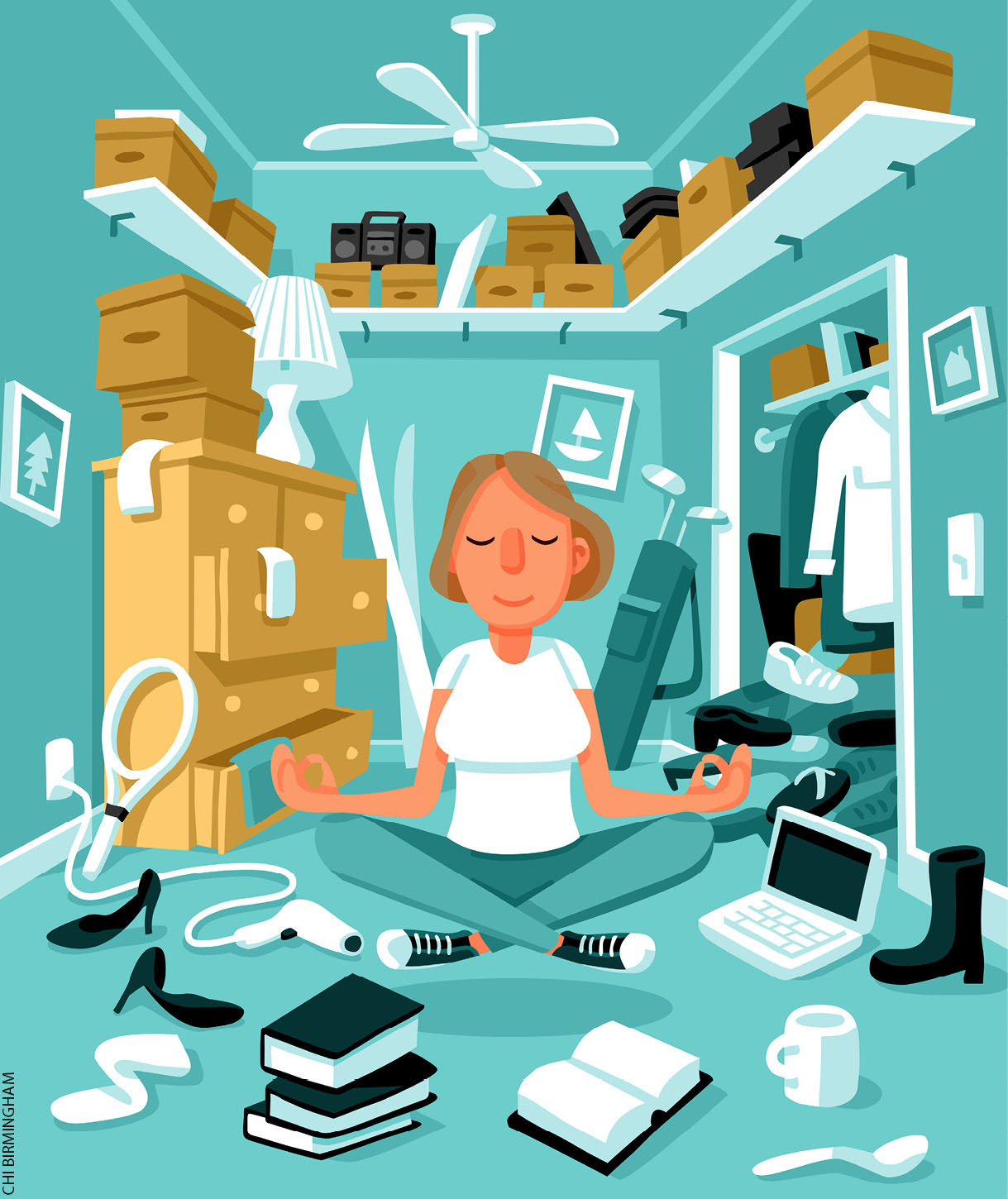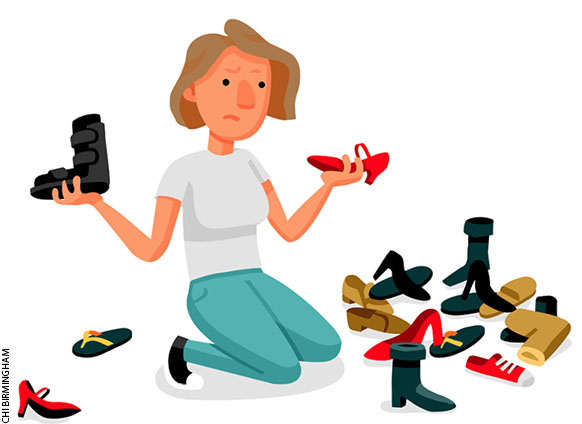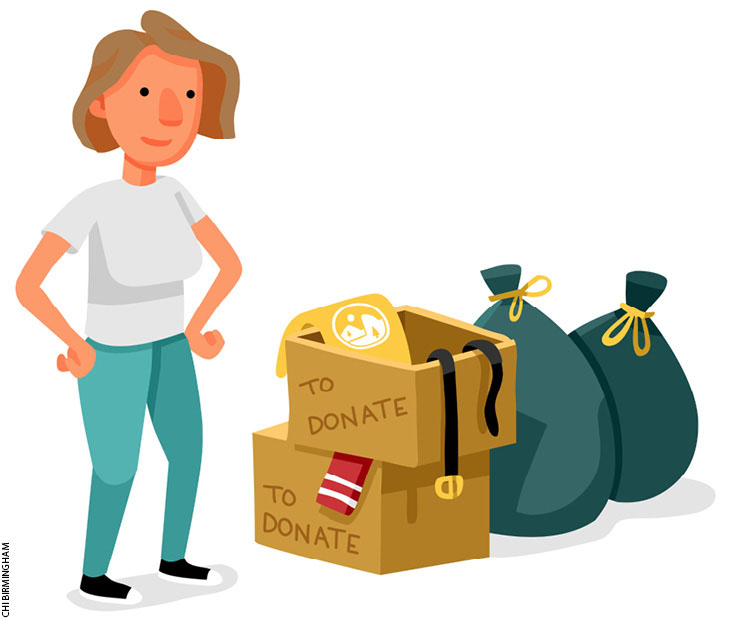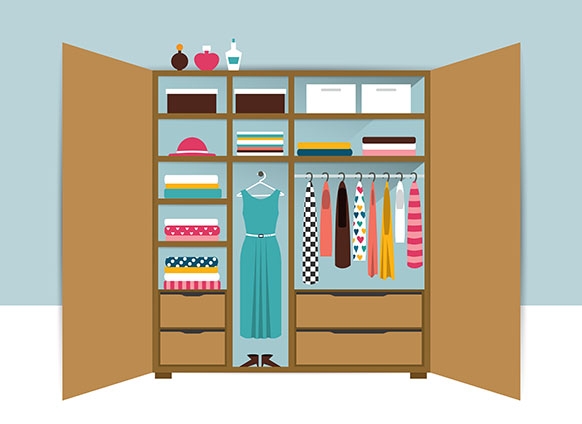On a Sunday morning, like millions of other people, I’m on my knees with my head bowed. There’s no pew in sight, though—just the floor of my basement as I pick through a pile of shoes, deciding which ones shall abide with the flock and which ones shall be cast into the darkness of a Hefty bag bound for Goodwill.
Once you have experienced what it’s like to have a truly ordered house, you’ll feel your whole world brighten, booms the sermon in my head. Never again will you revert to clutter. They’re the words of Marie Kondo, the Japanese author whose best-seller The Life-Changing Magic of Tidying Up has turned domestic self-help into scripture.
Tidying your home, she preaches, will lead to improvements in every other area of your life: health, career, relationships. She couldn’t have timed her message better. Minimalism, with a focus on slimmed-down homes and schedules, has been rising. Meanwhile, woes ranging from violence to climate change leave plenty of us desperate to feel some control, even if it’s just within our own small spheres.
Related: How Living With Less Can Give You More
More than 4 million copies of The Life-Changing Magic of Tidying Up have sold worldwide. Kondo’s followers, aka “Konverts,” cheerfully post photos online of their spiffy closets and underwear drawers.
But can this new bible really deliver the rewards she promises—the brightened world, the transformed life? Can her “KonMari Method” help even the many, many of us who have repented countless times for our slobdom, only to sin again with towers of unread copies of The New Yorker? When SUCCESS asked me to try obeying Kondo’s commandments, I was skeptical. Not only am I one of those sinners, I’m married to another and have given birth to two more. Although I love being in orderly spaces, I have seldom maintained one for more than a few days. My messiness is a joke among extended family. Not long ago, I almost broke a leg when I slipped in my office on a carpet of paperwork.
Still, I agreed to give KonMari a whirl—and not just because this was probably the one time I’d ever get paid to clean my house.
“Tidying is this hugely intimate, personal conversation with yourself about who you are right now, what you love, what matters to you.”
I also couldn’t help being impressed by Kondo’s bona fides. She has famously been obsessed with tidying since she first immersed herself in “home and lifestyle magazines” at age 5. She began developing KonMari while in high school and spent five years helping maintain a Shinto shrine. She runs a tidiness-consulting business in Tokyo with a three-month waiting list.
If anyone could turn me into a born-again neatnik, I figured it was Kondo.
THOU SHALT CHUCK WHAT THOU DOST NOT LOVE.
The secret to tidying success, according to Kondo, is to do it “in one shot, as quickly and completely as possible, and to start by discarding.”
Before you dive in, though, she wants you to motivate yourself to go the distance: “Think in concrete terms so that you can vividly picture what it would be like to live in a clutter-free space.”
For me, this meant imagining myself writing in an office without booby traps underfoot. Doing Pilates in a sunroom that didn’t double as a sanctuary for random boxes. Cooking in a kitchen where storage containers didn’t tumble from their crowded shelves and bonk me on the head.
This was, indeed, motivating.
I felt as ready as I’d ever be for the big purge and for what is undoubtedly Kondo’s best-known piece of advice: While deciding what to keep, take each of your belongings in your hands and ask, “Does this spark joy?” If the answer is no, if the object doesn’t “speak to your heart,” let it go. (Of course, joy seems a bit much to demand of a toilet brush. Kondo herself seems to have softened in this department; in Spark Joy, a new companion to her first book, she concedes that simply finding something useful may “indicate joy.”)
Go category by category in your joy-testing, Kondo says—clothes, books, papers, miscellaneous, and sentimental items, in that order—not stopping until you have decided to keep or dump every single thing you own. The momentum of an all-out campaign is crucial to prevent backsliding, she insists. You should finish within six months.
Which is how I found myself on the floor, surrounded by shoes.
Why shoes? Kondo says to start with things you wear because they’re relatively easy to decide about. Later, when you comb through trickier items—letters, family photos—you’ll have built some joy-detecting muscle to see you through.

Why the floor? Kondo insists on it. “By exposing [possessions] to the light of day and jolting them alive, so to speak, you’ll find it’s surprisingly easy to judge whether they touch your heart.”
Indeed, as I grabbed pairs of shoes, “Does this spark joy?” took little time to answer. (No, these sandals spark foot cramps; yes, these slippers are super-comfy.) I’ve never been too sentimental about footwear.
Maybe this whole KonMari thing would be a snap after all.
TALLY, WEEK ONE:
Bags of shoes to donate: two.
Bags and recycling bins of other stuff from the same closets: four (more on that later).
Minutes of feeling more peaceful and virtuous: too many to count.
THOU SHALT INTROSPECT AND AGONIZE.
Then came clothing and accessories—and with them, waves of waffling.
Could I bear to put two unworn but unflattering double-wrap belts in the Goodwill bag, thereby admitting I had wasted money on them? And what if I needed them down the road for something unforeseen—a Halloween costume, say, in which I impersonated a hot dog tied with twine?
How about three T-shirts from when my husband and I were carefree, kid-free and living in California? I didn’t wear them anymore, but oh, the memories they brought back of hiking in Yosemite and juggling in Laguna Beach!
And what of the scarves knitted for me by my late Aunt Ethel? They had always been weirdly short, but wasn’t it disloyal to get rid of them?
Such moments made me long to talk to Kondo about how tidying doesn’t just spark joy, it kindles angst. Sadly, although she may be a master of managing home clutter, her backlog of promised interviews was six weeks long. I didn’t have that kind of time. But I did have the next-best thing: Sue Rasmussen, a Minneapolis life coach and clutter buster who has worked with more than 6,000 clients individually and in groups. Although her views don’t always mesh with Kondo’s, she says she loved her book and its message. And she was happy to chat.
“Tidying is this hugely intimate, personal conversation with yourself about who you are right now, what you love, what matters to you,” Rasmussen says. As a society, we’re conditioned to think less about our feelings and more about what’s sensible, what we owe others, what we’ve been told we should like. We get out of practice at listening to our own hearts, she says. Tidying is “reconnecting to that part of yourself that knows you really like the red fancy shoes.”
Or that you loathe the double-wrap belts.
One by one, thanks to Kondo’s sound advice on guilt, nostalgia and fear of scarcity, I was able to make my choices.
The belts had already done their job, I told myself, just by giving me a thrill when I bought them and imagined a more fashionable me. And luckily I could afford to buy different belts if Halloween inspiration struck. As Kondo does with her discards, I thanked them for their service. (Yes, there’s a quirky strain of animism in her book. Your possessions “want to help you.” Your socks are dying for a “rest.”)
I scrapped the California tees too. My memories of mountains and beaches didn’t depend on whether certain pieces of cloth clogged my dresser.
And I said goodbye to the scarves. Their true purpose—being received and reminding me of Aunt Ethel’s love—had been served. She wouldn’t have wanted me to hang onto them out of guilt. And besides, back when Aunt Ethel moved to a smaller apartment, hadn’t she tossed a gorgeous set of coasters I gave her?
TALLY, WEEK TWO
Bags and recycling bins: five.
Relief that I no longer had to glimpse those belts in the closet and feel bad about not wearing them: palpable.
ANNOY NOT THY FAMILY.
Later, I admit, my daughter took the belts and my son took one of the T-shirts. But I didn’t pressure them, I swear.
“We need to show consideration for others by helping them avoid the burden of owning more than they need or can enjoy,” Kondo says. Hear, hear.
I also didn’t nag my family into tidying with me—not because I’m above nagging, but because it never works. Instead I had decided to take another page from Kondo and see whether I could lead by example.
Though some critics have accused her of feeding the sexist idea that tidying is just for women, Kondo, in fact, admonishes readers not to spruce up other people’s spaces. “To quietly work away at disposing of your own excess is actually the best way of dealing with a family that doesn’t tidy,” she writes. “As if drawn into your wake, they will begin weeding out unnecessary belongings and tidying without your having to utter a single complaint.”
So I craftily invited Lily, age 10, to tour my spectacular dresser drawers. Not only does Kondo tell you how to purge, she tells you how to fold: Instead of piling items on each other, you turn them into origami-like bundles (Spark Joy has illustrations) and then line them up horizontally so every item is visible. No rooting around for the shirt you want. No steaming out wrinkles caused by the weight of stacked clothes.

Lily looked impressed, but not as impressed as I was a few hours later when I saw that she’d not only KonMaried two of her drawers, she had tidied much of her room.
Right around the same time, my 16-year-old, Davey, cleaned his room, too. He hadn’t even seen my drawers.
Could my husband be drawn in next?
Day in and day out as I tidied, the reef of clothes, books and papers next to Bill’s side of the bed had remained. More ominous still, in a corner of one closet I had found an orthopedic boot from when he broke a foot three years earlier. I asked his permission to ditch the boot. “Better not,” he said. “We should keep it for the next time one of us breaks a foot.” He was serious.
I refused to abandon hope, though. Unlike some men, Bill does more than his share of housework. Plus, I may have asked an ever-so-slightly-loaded question one night. Glancing at the bedside reef, I said, “Doesn’t clutter ever oppress you?”
“Not really,” Bill said.
Two days later, I noticed the reef had begun to shrink.
TALLY, WEEK THREE
Bags and bins: three.
Number of times I opened my dresser to smile at my pretty rows of sweaters as if they were bins of gelato: embarrassing.
REALIZE THOU ART LIVING BETTER.
A month into KonMariage, I had a long way to go. My office was neater but hardly pristine. The sunroom was still half-full of boxes. But the house now contained many pockets of calm—including two closets, two cabinets, 17 drawers, my desk, the sink top in the master bathroom, and those formerly nasty kitchen shelves, from which I had eliminated enough plastic takeout containers to outfit a Chinese restaurant for days.
Thanks to such no-longer-overflowing pockets, I found I was much better about putting stuff away. (Kondo: “Once you learn to choose your belongings properly, you will be left only with the amount that fits perfectly in the space you already own.”)
“Once you have experienced what it’s like to have a truly ordered house, you’ll feel your whole world brighten.”
And to my surprise, even though I had yet to finish tidying, I had begun—as Kondo promised—to change my life in bigger ways, too.
I was writing more poems and spending less time on Facebook. I was exercising more and binge-watching Netflix less. Instead of relying almost every night on convenience foods, I made pot roast and lentil soup.
When online sales hit, I resisted the siren call of new clothes. My old ones—suddenly visible and appreciated thanks to KonMari folding and joy-testing—felt like enough.
I volunteered at my kids’ schools way more than usual.
What was going on?
As you decide what to surround yourself with in your home, Rasmussen tells me, you become more adept at choosing what to keep, dump and seek in your career and relationships. “Tidying lets you stare in the face all of your core beliefs and what you’re living your life based on.”
It also gives you more energy, she and Kondo believe.
“I imagine you are connected to everything you own—every single paper and paper clip—with a tiny thread,” Rasmussen says. “The stuff that brings you joy and that you are using gives you something back—it’s giving you a boost of energy. The stuff that makes you feel guilty, the stuff that makes you feel fat, sucks your energy.” When you get rid of the unloved stuff, the energy comes zinging back to you.
Research supports the notion that clutter—or its absence—can have a real physical and emotional effect.
In a 2009 study, University of California-Los Angeles psychologists found that women who feel their homes are cluttered tend to be less happy with their marriages, have unhealthy patterns of the stress hormone cortisol, and get increasingly depressed throughout the day. It makes sense, then, that (at least among women) tidying might be good for the body and mind. Husbands in that study were relatively unaffected by clutter, it’s true. Still, I wouldn’t rule out men. The night I tidied the kitchen shelves, Bill kissed me. “This is fantastic!” he said. No longer would he live in fear of containers raining down on him while he unloaded the dishwasher. His good mood lasted the rest of the night.

TALLY, WEEK FOUR
Bags: four.
Hope that, thanks to the momentum inspired by Kondo, my whole house would eventually be neat: high—even though I hadn’t always been the most faithful of Konverts.
THOU SHALT NOT BEAT THYSELF UP.
Since my tidying project began, I have transgressed against Kondo’s teachings in a number of ways. These are my confessions:
I haven’t always gone category by category, rather than location by location.
Kondo is strict about this: Tidy just the type of item that’s on your list that day and leave everything else for another time. But I knew right away that this would make me crazy. To find all the shoes that needed tidying, I had to empty two closets. Did it make sense to KonMari only the shoes, and then return a hash of other stuff to the closet untouched? It did not. So I joy-tested all sorts of items, ranging from carpet pad remnants to an old cat bed, and wound up with two neat closets that give me a lift every time I open them.
I have peeked inside books and magazines while deciding which ones to keep.
Kondo says not to do this, lest it “cloud your judgment.” But how can you judge whether a book sparks joy if you don’t know what it says?
I have seldom spread items to be tidied on the floor.
Probably unlike Kondo, I don’t scrub all my household surfaces daily or even weekly. So the idea of later putting away floor-seasoned tank tops and Tupperware was a no-go. Spreading things out on a table or bed works just fine. (Germs or no germs, I’d never put all my books on the floor anyway. While Kondo says she owns 30, I have at least 1,200. If I sat with them heaped around me, I might not get out alive.)
I have tidied categories out of turn.
Why spend time on scarves, for instance, when kitchen goods were becoming a menace?
I have gone too slowly to make the six-month deadline.
Family, friends and work have taken precedence and will continue to do so.
After admitting all of the above to Rasmussen, I was relieved that she still seemed to think I might one day enter the Kingdom of Apple-Pie Order.
Kondo’s decree notwithstanding (“Do not change the method to suit your personality”), plenty of Rasmussen’s clients do just fine tidying in other ways. So does Rasmussen. Instead of folding her clothes à la Kondo, for instance, she hangs them. Instead of approaching tidying as a marathon, she sees it as a lifelong practice. And yet she lives in a home as clutter-free as Kondo’s, with four necklaces to her name and nothing on the front of her fridge.
“Our brains are always looking for somebody else’s answer for us—it’s very tempting,” Rasmussen says. “The truth is we can take bits and pieces of things we like and make them our own so that they make us really happy.”
Hmmm. Sounds an awful lot like the KonMari method to me. Only instead of joy-testing objects, it’s joy-testing techniques.
Exactly, Rasmussen says. “I always encourage people to use their same criteria for their stuff as they would for advice, guidelines, rules. Chuck the part you don’t like and keep what you do.”
To which I say: amen.
Related: Clean Up Your Act
This article appears in the April 2016 issue of SUCCESS magazine.










